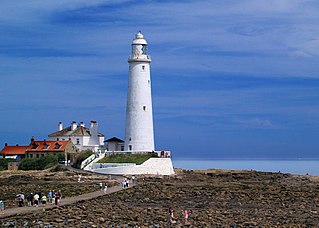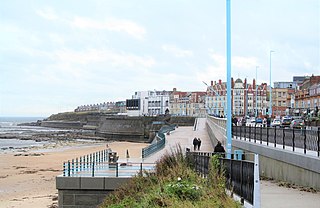
North Tyneside is a metropolitan borough in the metropolitan county of Tyne and Wear, England. It forms part of the greater Tyneside conurbation. North Tyneside Council is headquartered at Cobalt Park, Wallsend.

Whitley Bay is a seaside town in the North Tyneside borough in Tyne and Wear, England. It formerly governed as part of Northumberland and has been part of Tyne and Wear since 1974. It is part of the wider Tyneside built-up area, being around 10 miles (16 km) east of Newcastle upon Tyne. Two notable landmarks are the Spanish City and St. Mary's Lighthouse, the latter on a small island near the town.
Monkseaton is an area of Whitley Bay, North Tyneside, in the North East of England. Historically in Northumberland, it is in the north-east of the borough, 3⁄4 mile from the North Sea coast and 1+1⁄2 mi (2.5 km) north of the River Tyne at North Shields. One mile to the north of Monkseaton, the extensive built-up areas of North Tyneside change abruptly into green belt stretching north into south-east Northumberland. It is at an elevation of 130 feet (40 m) above sea-level.

The North Tyneside Steam Railway and Stephenson Steam Railway are visitor attractions in North Shields, North East England. The museum and railway workshops share a building on Middle Engine Lane adjacent to the Silverlink Retail Park. The railway is a standard gauge line, running south for 2 miles (3.2 km) from the museum to Percy Main. The railway is operated by the North Tyneside Steam Railway Association (NTSRA). The museum is managed by Tyne and Wear Archives and Museums on behalf of North Tyneside Council.

Earsdon is a village in the borough of North Tyneside in the county of Tyne and Wear, England. It sits on the border of Northumberland, which it is historically part of, and is approximately two miles from Whitley Bay. The village had a population of 613 in 2011.

Wylam is a village and civil parish in the county of Northumberland. It is located about 10 miles (16 km) west of Newcastle upon Tyne.

Tynemouth is a constituency in Tyne and Wear represented in the House of Commons of the UK Parliament since 1997 by Sir Alan Campbell, a member of the Labour Party.

Shiremoor is a Tyne and Wear Metro station, serving the village of Shiremoor, North Tyneside in Tyne and Wear, England. It joined the network on 11 August 1980, following the opening of the first phase of the network, between Haymarket and Tynemouth via Four Lane Ends.

Seaton Valley was an urban district in Northumberland, England, from 1935 to 1974, at which point it was split between the districts of North Tyneside and Blyth Valley.

Northumberland Park is a Tyne and Wear Metro and future National Rail station, serving the village of Backworth and suburbs of Northumberland Park and West Allotment, North Tyneside in Tyne and Wear, England. It joined the network on 11 December 2005, and is the second-newest station on the network as of March 2022.

Shiremoor is a village in Tyne and Wear, Northern England. It is in the Metropolitan Borough of North Tyneside and formerly governed under Northumberland. In the 2011 census, it was included in the Tynemouth area of Tyneside. It is near the North East Green Belt, which surrounds Tyneside, Wearside and Durham. It is located around 3+1⁄2 miles from Whitley Bay.
The North Tyneside Loop refers to the railway lines in North Tyneside from Newcastle upon Tyne via Wallsend, North Shields, Whitley Bay, Backworth, Benton and South Gosforth back to Newcastle. Since the 1980s, it has formed part of the Tyne and Wear Metro, albeit in modified form.
The Blyth and Tyne Railway was a railway company in Northumberland, England, incorporated by Act of Parliament on 30 June 1852. It was created to unify the various private railways and waggonways built to carry coal from the Northumberland coalfield to Blyth and the River Tyne, which it took control of on 1st January 1853. Over time, the railway expanded its network to reach Morpeth (1857/8), North Seaton (1859), Tynemouth (1860/1), Newcastle upon Tyne (1864), and finally Newbiggin-by-the-Sea (1872). It became part of the much larger North Eastern Railway in 1874.
Tynemouth was a rural district in the English county of Northumberland.

Backworth railway station served part of Newcastle in the English county of Northumberland, later part of Tyne and Wear. The station opened as Hotspur, replacing another Backworth station on the line to Morpeth which had been opened as Holywell.

Murton is a small village in the metropolitan borough of North Tyneside, in the ceremonial county of Tyne and Wear, England. The village is separated by fields from the nearby areas of West Monkseaton, New York, Earsdon and Shiremoor. Until 1974 Murton was in Northumberland. Murton was a civil parish between 1866 and 1935. In 1931 the parish had a population of 1164.
The county of Northumberland has returned four MPs to the UK Parliament since 1983. Under the Local Government Act 1972, which came into effect on 1 April 1974, the boundaries of the historic/administrative county were significantly altered with the south-east of the county, comprising more than half the electorate, being transferred to the new metropolitan county of Tyne and Wear. These changes were reflected in the following redistribution of parliamentary seats which did not come into effect until the 1983 general election, resulting in a reduction in the county's representation from 10 to 4 MPs.













